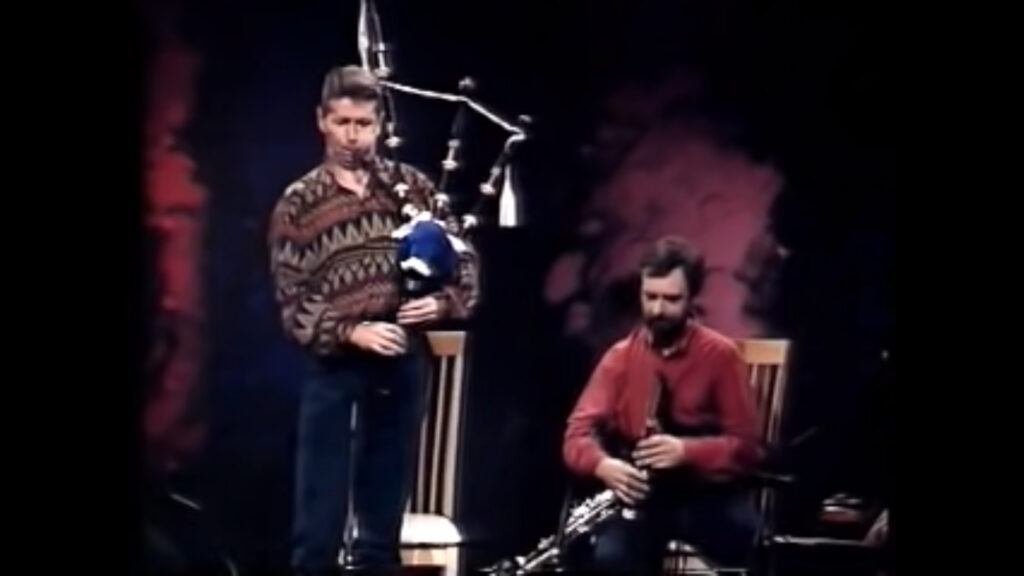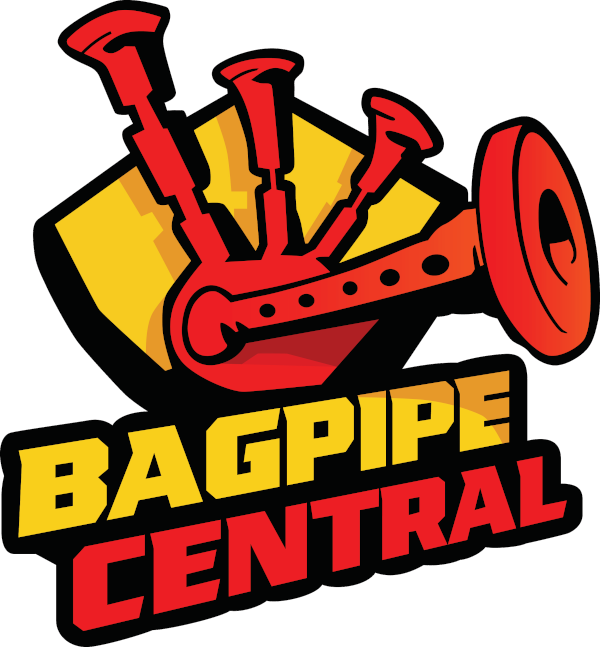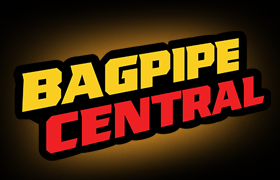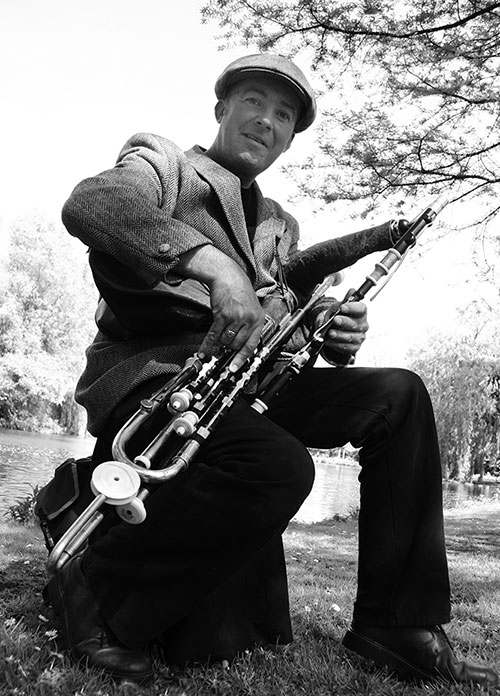Dicky Deegan playing his Uilleann/Union pipes made by Geoff Wooff in 1988. These pipes are a replica of a 19th century (1850) J. Coyne C# full set with double-bass regulator that were discovered in an attic in Hobart Tasmania in 1984. There are only two of these sets in the world – the original and Dicky’s set made by Geoff Wooff. The photograph was taken by Jennette Plooij in the Vondelpark, Amsterdam while Dicky was on a European tour.
If you’ve ever visited an Irish pub, you might have crossed paths with the Uillean pipes. The Uillean piper is less likely to be standing on a street corner busking. In Scotland the sound of the Great Highland pipe can carry the length of the high street. In Ireland, you are more likely to find a piper seated. There in the corner of a pub, you might see the Uillean pipes. The player is more apt to be chatting with the people next to him. A bag tucked neatly beneath one arm, and a bellow under the other.
Their History and Origin
The Uilleann pipes (sometimes misspelled as Uillean Pipes) have become known as the characteristic national bagpipe of Ireland. They have a different harmonic structure . Therefore, this makes them sound sweeter and softer than the better known Scottish bagpipe. Along with the Scottish Great Highland pipes, the Uilleann pipes have become synonymous with Irish culture, and celebrated by Irish people.
In earlier days they had been known as Union pipes. Their modern name was actually invented by Irish author and historian Grattan Flood. He used an Irish word to describe these bagpipes. Additionally, these pipes differ in construction from what we typically think of as Scottish bagpipes, or great highland bagpipes. The phrase píobaí uilleann translates to “pipes of the elbow”. Those familiar with their method of use have probably heard them referred to as simply “elbow pipes”.
Differences
The great highland bagpipe relies on the player to continuously blow into a mouthpiece to inflate the bag. Irish pipes make use of a small set of bellows (a device used to produce a small blast of air). The bellows allow a player more freedom to converse with those around them. They can even sing along with a set (though this requires a lot of concentration). It is a dry air that is being pushed back and forth between the bellows and bag of the Ulliean pipes. This means they are not as vulnerable to the moisture and humidity that can interfere with highland bagpipes.

Check out this video of two amazing musicians playing Uilleann and the Great Highland Pipes.
Getting Started
There is some literature available on the set-up, maintenance, and lessons for the Irish pipes. Check out: The Davy Spillane Uilleann Pipe Tutor, or Wilbert Garvin’s, Irish Bagpipes: Their Construction and Maintenance. Like any musical instrument it is beneficial to find yourself a tutor. You can also pick up a reasonably priced practice set before diving in on your own. YouTube, and other online platforms can help with set-up and beginner lessons. You can find instructional lessons free online. You can also find hints and hacks to set up your new bagpipe. Videos are helpful to explore the wide range of notes that is available on the Irish bagpipe.
If you are familiar with the great highland bagpipe, you know that it has four reeds. Three in the drones, and one double reed in the chanter. The Irish pipes actually have seven reeds. Four of these reeds are are double reeds like that in the chanter of the great highland bagpipe, an oboe, bassoon, or even a practice chanter. The other three are single reeds, like a clarinet, or those found in the drones of the Scottish pipes.
Harmonic Range
Unlike the great highland bagpipe (let’s refer to this as GBH), the Uilleann pipes have a two-octave range. This includes sharps and flats. The second octave is produced by overblowing the chanter. You cannot do this on most bagpipe chanter. Think of it like a tin whistle, which are overblown to achieve a higher octave. If you overblow a double reed on the GHB, you’ll simple choke the reed and it will cut out. This helps create that much softer and sweeter sound we think of when we hear Irish pipes. They are more suitable to be played inside. They are much quieter than the GHB. This makes it easier to sit in a circle of musicians without drowning everyone out.
Bagpipe Music
There is definitely a distinctive Irish influence to bagpipe music written for the Uillean pipe. But you can play within the range of the GBH which makes all tunes available. People often dance to the Uillean pipe, the same way you would see anyone dance to the GHB or fiddle.
Different types of bagpipes naturally have some variances in sound. The tone of the Uilleann bagpipes is different because of its harmonic structure. They are also sweeter and quieter than that of the Great Irish Warpipes. Irish Warpipes are comparable to the better known Scottish bagpipe of modern times. If you are unfamiliar with piping you might be surprised to discover that there have been many forms of bagpipes. Some have stuck around for generations, while others have evolved into the more typical instruments we see today.
The Uilleann pipe emerged alongside the Northumbrian smallpipes, and Scottish Lowland pipes. The earliest surviving Uillean set of pipes dating back to the eighteenth century. It’s theorized that the Irish pipes might have originated from pastoral bagpipes. These were a small bellows-blown pipe with a two-octave chromatic scale.
Set-Up
A player can use a full set of Uilleann pipes, as well as a half set. The full-set includes a chanter, drones, and regulators, while the main difference with the half-set being the lack of regulators. A practice set lacks both the regulators and drones, which makes it a much simpler introduction to Uilleann piping. All three are used in professional performance. The Uilleann, just like the older pastoral pipes, and the GBH, can all use an animal skin bags. Bags are also available in synthetic materials. Air is passed by a means of a small set of bellows. This magnificent instrument does not suffer the same adverse effects of moisture that a mouth blown pipe would experience. Therefore, caring for the Uillean pipes might be slightly easier than mouth blown pipes. Moisture can damage the playability of an instrument if not properly managed.
Chanter
Like all bagpipes, the chanter of the Irish bagpipe allows the user to play the melody. It has eight finger holes (like the GHB). You can produce staccato notes on the Uilleann pipe by sealing off the bottom. You cannot do this on the GBH. Sealing the bottom of the chanter is also how one is able to achieve the second octave. People sometimes use a piece of leather draped over their knee to seal the pipe. When the chanter is closed, and pressure on the bag increased, the second octave will sound.
Wrapping Up
So, if you’re interested in getting started with the Uilleann pipes, check out na píobairí uilleann. They are a non-profit organization dedicated to the Uilleann pipes and traditional Irish music. There are plenty of online communities to find support for an enthusiast or advanced player. They can give you more information on initial cost, and what you should be spending on a beginner set. You can also check out our post on the cost of bagpipes. While it is not focused on the Uillean specifically, you’ll find that many of the same rules and expectations apply.
Submitted by
Jennifer MacLellan
Bagpipe Central
Please contact us if you have an idea that you would like to share with our audience.


